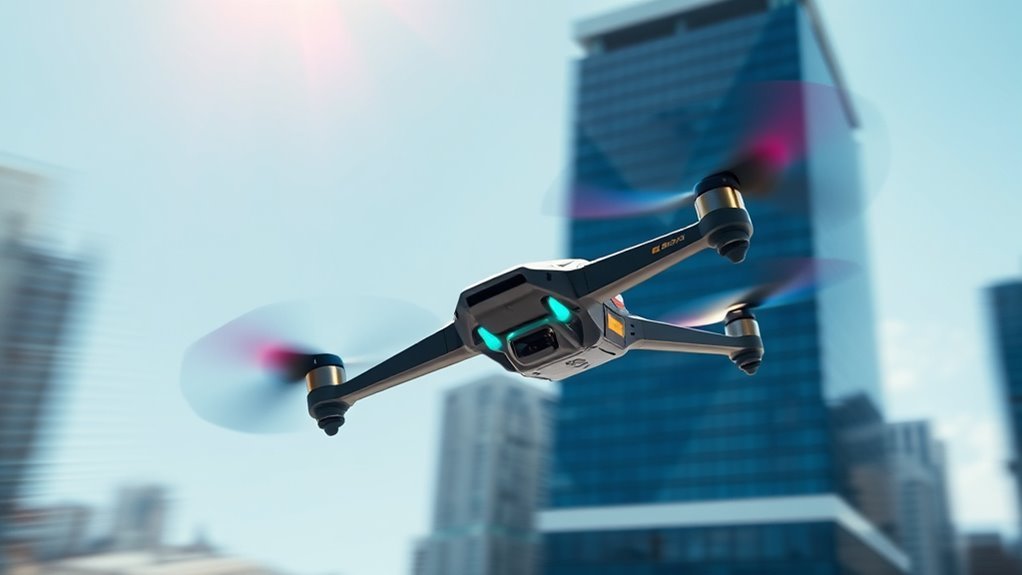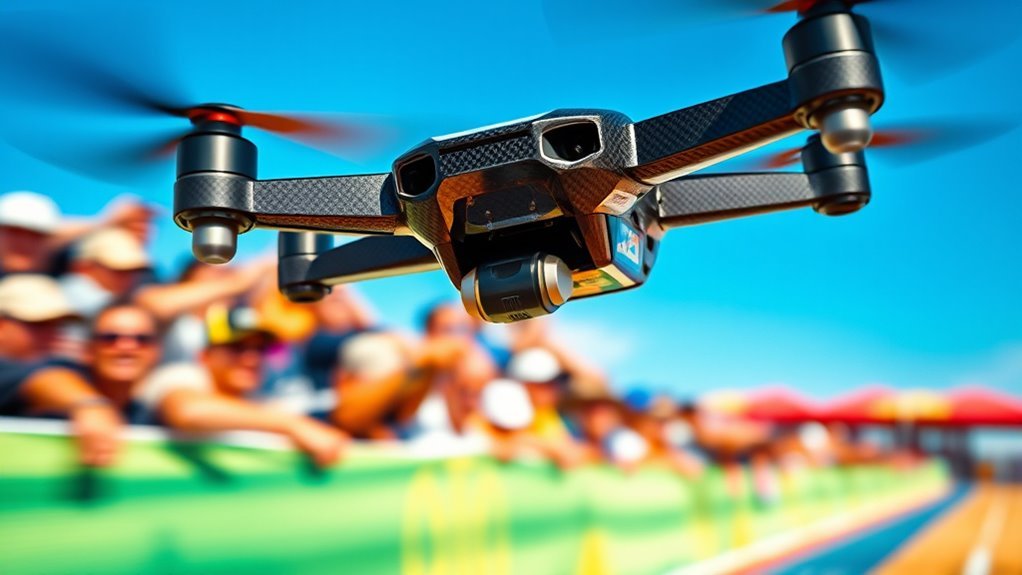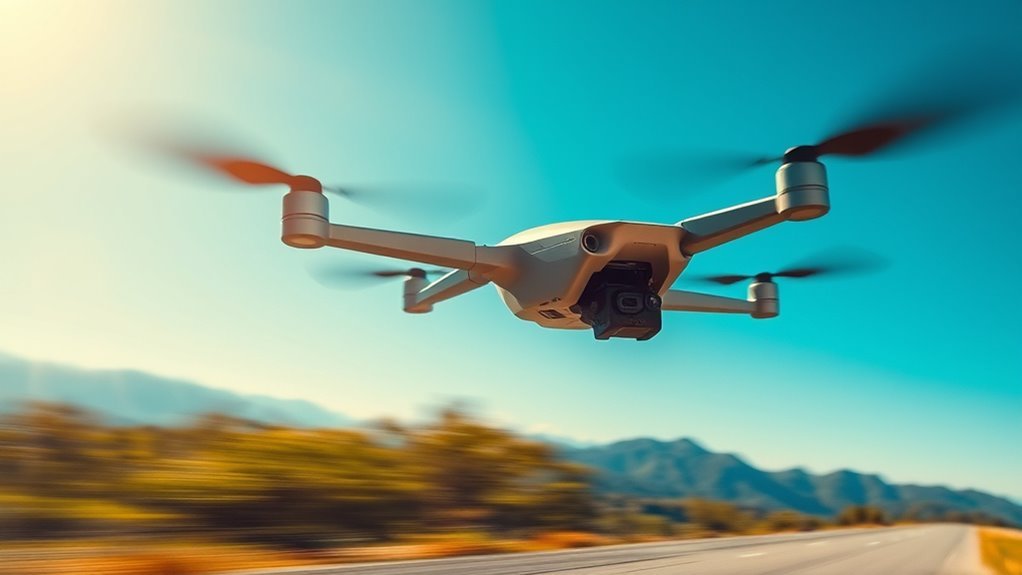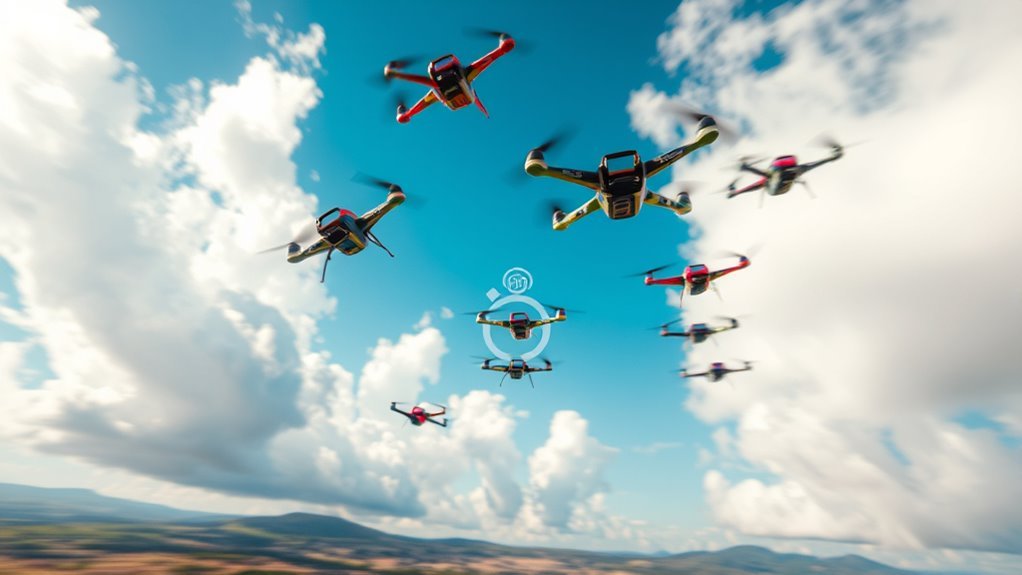Fast racing drones have reached astounding speeds, with the current top-performing models exceeding 200 mph. These machines utilize advanced materials like carbon fiber, aerodynamic designs, and powerful propulsion systems to achieve such velocities. The integration of sophisticated flight controllers also enhances precision and maneuverability, allowing pilots to navigate complex courses effectively. As technology evolves, these speeds are likely to increase even further. Explore how design, weight distribution, and pilot skill contribute to this thrilling sport’s advancements.
The Evolution of Racing Drones

As racing drones have evolved, they’ve transformed from hobbyist gadgets into high-performance machines that dominate competitive landscapes. The advancements in drone design focus on weight reduction, aerodynamic efficiency, and enhanced maneuverability. You’ll notice that today’s racing drones are meticulously engineered with lightweight materials like carbon fiber, allowing for rapid acceleration and agility. Racing leagues have emerged to showcase these innovations, fostering a competitive environment where technology and piloting skills collide. The integration of advanced flight controllers and high-performance motors further enhances their capabilities, enabling precise navigation through complex courses. With these developments, freedom in design and performance has become paramount, allowing pilots to push boundaries and redefine what’s possible in drone racing. Embracing these changes, you’ll find yourself immersed in an exhilarating world of speed and skill.
Record-Breaking Speeds in Drone Racing

With the advancements in technology and design, racing drones now achieve astonishing speeds that were once unimaginable. These machines have redefined the limits of drone racing, especially in various racing championships where competitors push their machines to the max. Here are some key highlights of record-breaking speeds:
- World Record Speeds: Drones have clocked in at speeds exceeding 200 mph, setting new benchmarks.
- Race Course Challenges: These drones navigate intricate courses, demonstrating agility while maintaining record times.
- Innovative Designs: Manufacturers are continually innovating, optimizing weight and aerodynamics for peak performance.
As drone racing evolves, it’s clear that the thrill of breaking records fuels both the technology and the sport itself, granting pilots the freedom to soar beyond previous limits.
Top 5 Fastest Racing Drones of 2023

In this section, we’ll examine the top five racing drones of 2023, focusing on their impressive speeds. You’ll find a speed comparison chart that highlights the performance differences, along with an overview of key features that contribute to their capabilities. Understanding these elements will help you assess which drone stands out in the competitive racing landscape.
Speed Comparison Chart
The top five fastest racing drones of 2023 showcase impressive advancements in technology and aerodynamics, making them formidable contenders on the circuit. Speed testing reveals their capabilities, but it’s crucial to navigate drone regulations to maximize performance safely. Here’s a quick comparison of their speeds:
- Drone A – 120 mph
- Drone B – 115 mph
- Drone C – 110 mph
These drones not only push the limits of speed but also incorporate cutting-edge materials and designs. As you consider your next racing drone, keep in mind how these speeds align with your goals and the regulatory landscape. Staying informed on drone regulations can help you harness their full potential on the racing circuit.
Key Features Overview
While speed is a critical factor in racing drones, their key features greatly influence performance and user experience. The top racing drones of 2023 excel in drone agility, allowing for sharp turns and quick maneuvers essential for competitive racing. Their lightweight frames and high-thrust motors provide a perfect balance of speed and control, adhering to strict racing regulations. Advanced flight controllers enhance stability, ensuring you maintain precision during high-speed flights. Additionally, customizable settings enable you to tailor performance to your style, maximizing your competitive edge. High-definition FPV cameras offer real-time feedback, enhancing situational awareness. Ultimately, these features combine to create an exhilarating racing experience, granting you the freedom to push your limits and soar to new heights.
Key Features That Enhance Speed
To achieve maximum speed in racing drones, a lightweight frame design is essential, as it minimizes drag and enhances maneuverability. Additionally, a powerful propulsion system provides the necessary thrust to reach higher velocities quickly. Together, these features greatly influence a drone’s overall performance in competitive settings. Moreover, the aerodynamic design of the drone contributes significantly to its stability and speed during high-speed maneuvers.
Lightweight Frame Design
When optimizing for speed in racing drones, a lightweight frame design is essential, as it greatly reduces inertia and allows for quicker maneuvers. Achieving this balance requires careful material selection and attention to frame rigidity. Here are three key features to take into account:
- Material Selection: Utilizing advanced composites like carbon fiber minimizes weight while maintaining strength.
- Structural Design: Incorporating a minimalist design reduces unnecessary bulk, enhancing aerodynamic efficiency.
- Reinforcement Techniques: Strategically placed braces can improve frame rigidity without considerably adding weight.
Powerful Propulsion System
A powerful propulsion system is essential for maximizing the speed of racing drones, and several key features contribute to this capability. First, consider the motors; high-performance brushless motors provide superior propulsion efficiency, enabling quicker acceleration and higher top speeds. The choice of propellers also plays a vital role; larger, well-designed propellers enhance thrust to weight ratios, allowing drones to climb and maneuver with agility. Additionally, the battery’s discharge rate impacts overall performance, as it must supply sufficient power without compromising weight. An optimized electronic speed controller (ESC) further refines motor response, ensuring rapid adjustments to throttle inputs. By focusing on these elements, you’ll achieve a propulsion system that not only maximizes speed but also provides the freedom to explore dynamic racing environments.
The Impact of Weight and Design
While racing drones may seem similar at a glance, the nuances of weight and design profoundly influence their performance. Proper weight distribution is essential for stability and agility, allowing your drone to maneuver swiftly during races. The choice of design materials also plays a significant role, impacting both the weight and durability of the craft. Consider these factors:
- Frame Material: Lightweight materials like carbon fiber can enhance speed without compromising strength. Additionally, aerodynamic shapes are crucial in minimizing drag, further boosting overall performance.
- Weight Optimization: Minimizing unnecessary components can drastically improve overall performance.
- Aerodynamic Design: A sleek profile reduces drag, enabling higher speeds and better control. Additionally, advanced motor efficiency can allow for quicker bursts of power, enhancing responsiveness during critical racing moments.
Battery Technology and Its Role in Speed
Although many factors contribute to a racing drone’s speed, battery technology is arguably one of the most essential elements. The battery capacity directly influences how long you can maintain high speeds during a race. A higher capacity allows for longer flight times, enabling you to push the limits without frequent pit stops. Additionally, charging efficiency plays a crucial role, as it affects how quickly you can get back in the air. Fast charging systems reduce downtime, letting you maximize your racing opportunities. Thus, when selecting a racing drone, consider not just the battery’s capacity but also its charging efficiency. This combination ultimately empowers you to achieve greater speeds and enjoy the exhilarating freedom that comes with high-performance racing.
Aerodynamics: The Science Behind Speed
Understanding aerodynamics is essential for maximizing a racing drone’s speed, as the design and shape of the drone greatly impact its ability to slice through air. Key factors influencing performance include:
- Drag Reduction: Streamlined designs minimize resistance, allowing the drone to maintain higher speeds with less energy consumption. Additionally, optimizing propeller size and pitch can significantly enhance thrust efficiency and speed.
- Lift Generation: A well-designed frame can generate ideal lift, enabling rapid ascents and greater maneuverability during races.
- Weight Distribution: Properly distributing weight enhances stability and control, which are critical for high-speed navigation. Additionally, understanding signal penetration challenges can help optimize the drone’s design for improved performance in various environments.
Pilot Skill and Its Influence on Performance
Even the most advanced racing drone can be outpaced by a skilled pilot, as the operator’s expertise plays an essential role in releasing the drone’s full potential. Pilot experience greatly influences performance; a seasoned pilot understands the nuances of handling, maneuvering, and optimizing drone responsiveness. Skill development is vital, as it enhances your ability to make split-second decisions and adapt to varying conditions. Practicing advanced techniques like throttle control and precise turns can dramatically affect your lap times. In addition, a pilot’s familiarity with the drone’s capabilities allows for better utilization of its speed and agility. Ultimately, the synergy between drone technology and pilot skill can lead to unprecedented performance, highlighting the importance of continuous learning and practice in competitive racing.
The Future of Racing Drone Technology
As technology advances, the future of racing drones is poised for significant transformation, driven by innovations in materials, design, and automation. You can expect several future innovations that will enhance performance and user experience:
- Advanced Materials: Lightweight, durable composites will reduce weight while increasing strength, allowing for faster speeds and better maneuverability.
- Autonomous Flight Systems: Technological advancements in AI will enable drones to make real-time decisions, enhancing racing strategies without pilot intervention.
- Battery Efficiency: Improved energy storage solutions will provide longer flight times and quicker recharge cycles, giving you more freedom during races.
These developments promise not just faster drones but also more thrilling, competitive experiences for enthusiasts and racers alike. Embrace the future of racing with these cutting-edge technologies!
Safety Considerations at High Speeds
While high speeds enhance the excitement of racing drones, they also introduce critical safety considerations that must be addressed to protect pilots, spectators, and property. To mitigate risks, it is crucial to implement preventative measures such as establishing designated racing zones and maintaining safe distances from crowds. Pilots should utilize advanced drone technology that includes fail-safes and collision avoidance systems to enhance crash safety. Regular maintenance checks and pre-race inspections can further reduce the likelihood of mechanical failures. Additionally, pilots must be aware that shooting down a drone can lead to serious legal consequences, emphasizing the importance of responsible drone operation. Pilots must also be trained in emergency protocols to respond effectively to potential accidents. By prioritizing these safety considerations, you can enjoy the thrill of racing while minimizing risks associated with high-speed drone operation. A proactive security posture should never come at the expense of safety.
Frequently Asked Questions
How Much Do Fast Racing Drones Typically Cost?
Fast racing drones typically range from $200 to over $1,000, depending on features and performance. You’ll find affordable options, but budget considerations are essential if you want to balance quality and cost effectively.
What Are the Best Brands for Racing Drones?
When you think of the best racing brands, doesn’t DJI and Fat Shark come to mind? Popular drone models like the ImmersionRC Vortex and Eachine Wizard offer thrilling performance, enhancing your freedom in the skies.
Can I Modify My Racing Drone for More Speed?
Yes, you can modify your racing drone for more speed. Consider speed upgrades like improved motors or propellers, and engage in drone tuning to optimize performance. Just make certain you follow regulations for safety and compliance.
What Is the Average Lifespan of a Racing Drone?
You’d think racing drones last forever, but they don’t. Typically, with proper drone maintenance and attention to battery longevity, you can expect about three to five years before performance noticeably declines. Enjoy the freedom while it lasts!
Are There Racing Drone Competitions for Beginners?
Yes, there are racing drone competitions for beginners. Focus on drone safety and follow beginner tips to enhance your experience. Engaging in these events can foster growth while enjoying the freedom of flying competitively.

